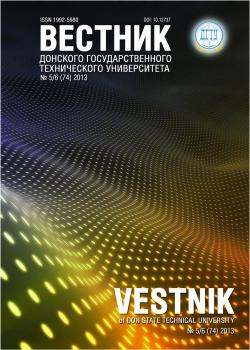Saratov, Saratov, Russian Federation
The smoothing throttle operations in the DC-motor circuit of a thyristor drive are studied. The main mathematical and graphic dependences of the smoothing throttle Lc inductance modification on the control angle, and on the number of the thyristor converter (TC) phases are given. The situation of the technological machine (TM) executing mechanism (EM) low conveying speed and of the armature pulsating current zone (PCZ) reduction is considered. In this case, it is reasonable to determine the minimal induction value of the smoothing throttle (Lc) at the boundary control angle aboun equal to 50—60 electric degrees for the increase in the mechanical characteristic rigidity of the DC motor. Then, the throttle magnetic conductor condition is defined by the branches of the specific limit asymmetric hysteresis cycle characterizing the electromagnetic processes in the magnetic conductor under the influence of the unipolar current pulses. Thus, the efficiency of the throttle core usage is defined through the incremental induction, i.e. through the difference in the residual induction B(0) levels, and the magnetic conductor material saturation induction. The airgap injection (δ) stabilizes the core equivalent magnetic capacity which can be broken by heating the throttle magnetic conductor with the armature current, by the environmental temperature fluctuations, and by the operation conditions of the thyristor drive. At the minimum inductance Lc of a smoothing throttle (for a boundary angle aboun), effects of the stabilizing factors of the core equivalent magnetic capacity (with airgap δ) decrease, PCZ is excluded. This permits to reduce electric losses in the power contour of the TC — DC-motor system, and also to form the required rigidity of the DC-motor mechanical characteristics, and the TM EM movement steadiness in the anchor low rotation frequency zones.
thyristor drive, smoothing throttle, control angle, continuous current, reduction of losses, pulsation coefficient.
Введение. Различные принципы преобразования электрической энергии находят применение в электромеханических системах (ЭМС) широкого назначения, в частности в структурах автоматизированного электропривода (АЭП) технологических машин (ТМ): промышленных роботов (ПР), металлорежущих станков и обрабатывающих модулей [1]. Важнейшее отличие управляемого АЭП — обеспечение программируемых технологических режимов работы ТМ, выполнимость требований к позиционированию исполнительного механизма (ИМ), включая и малые скорости его перемещения [2]. Традиционно тиристорный АЭП постоянного тока применяют в ТМ, где предусмотрено регулирование частоты вращения (перемещения ИМ), рабочего органа (РО) в широком диапазоне и с высоким быстродействием (при повышенной точности и равномерности его перемещения).Известно [3, 4, 5], что использование дополнительной индуктивности (сглаживающего дросселя Lc) в цепи двигателя постоянного тока (ДПТ) при питании от тиристорного (ТП) (или широтно-импульсного преобразователя (ШИП)) уменьшает зону прерывистых токов (ЗПТ) якоря, повышает линейность механических характеристик ДПТ, увеличивает диапазон регулирования скорости, способствует улучшению технических и энергетических показателей АЭП. Известно, что при малой индуктивности цепи якоря ДПТ и прерывистом токе создаётся неблагоприятный режим работы ДПТ, сопровождаемый дополнительными потерями электроэнергии, ухудшением коммутационных процессов в коллекторной цепи машины постоянного тока (МПТ) из-за превышения мак-
1. Lukinov, А. P. Proyektirovaniye mekhatronnykh i robototekhnicheskikh ustroystv : ucheb. Posobiye. [Mechatronic and robotic devices design : manual.] Sankt-Peterburg : Lan, 2012, 608 p. (in Russian).
2. Karnaukhov, N. F. Elektromekhanicheskiye i mekhatronnyye sistemy. [Electromechanical and mechatronic systems.] Rostov-na-Donu : Feniks, 2006, 320 p. (in Russian).
3. Perelmuter, V. M., Sidorenko, V. A. Sistemy upravleniya tiristornymi elektroprivodami posto-yannogo toka. [DC thyristor drive control systems.] Moscow : Energoatomizdat, 1988, 304 p. (in Russian).
4. Bulgakov, A. A. Novaya teoriya upravlyaemykh vypryamiteley. [A new theory of controlled rectifiers.] Moscow : Nauka, 1970, 320 p. (in Russian).
5. Karnaukhov, N. F, Filimonov, M. N., Bondarenko, A. V. О vozmozhnostyakh programmnogo upravleniya rezhimom dinamicheskogo tormozheniya dvigatelya postoyannogo toka pri pozitsionirovanii promyshlennogo robota. [On programmable controllability of DC motor regeneration under industrial robot positioning.] Informatsionnoye obespecheniye i upravleniye v mekhatronnykh proizvodstvennykh sistemakh : mezhvuz. cb. nauch. st. [Data support and control in mechatronic production systems: in-teruniversity coll. sci. papers.] Rostov-na-Donu, 1998, pp. 74-82 (in Russian).
6. Vdovin, S. S. Proyektirovaniye impulsnykh transformatorov. [Pulse trans-former design.] Leningrad : Energoatomizdat, 1991,148 p. (in Russian).
7. Karnaukhov, N. F, Mironenko, R. S., Filimonov, M. N. Skhema pitaniya elektroprivoda so sgla-zhivayushchim drosselem v tsepi postoyannogo toka : patent 2224350 Ros. Federaciya : H02M1/14, H02P5/16, H02P7/29, B60L15/08 /. [Feed circuit of smoothing-inductor electric driver in DC network.] Patent RF, no. 2224350, 2004 (in Russian).
8. Alexeyeva, N. N., et al. Tiristornyye reguliruyemyye elektroprivody postoyannogo toka. [DC controlled thyristor drives.] Moscow : Energiya, 1970,134 p. (in Russian).
9. Sidorov, I. N., Binnatov, M. F, Shvedova, L. G. Induktivnyye elementy radioelektronnoy appa-ratury : spravochnik. [Electronics inductive elements : reference guide.] Moscow : Radio i svyaz, 1992, 228 p. (in Russian).
10. Pozdnyakov, O. I. Elektroprivod promyshlennykh robotov : ucheb. posobiye. [Electric drive of industrial robots : manual.] Moscow : Izdatelstvo MPI, 1990,116 p. (in Russian).
11. Yerofeyev, A. A. Teoriya avtomaticheskogo upravleniya : uchebnik dlya vuzov. [Automatic control theory : college textbook.] 2nd revised and enlarged ed. Sankt-Peterburg : Politekhnika, 2001, 302 p. (in Russian).
12. Karnaukhov, N. R, Linkov, A. A., Yastrebov, A. Y. Problemy elektromagnitnoy sovmestimosti primeneniya preobrazovatelnykh ustroystv. [Problems of electromagnetic compatibility of converter installations usage.] Upravleniye. Konkurentosposobnost. Avtomatizatsiya : sb. nauch. tr. [Management. Competitiveness. Automation : coll. sci. papers.] Rostov-na-Donu : Izdatelstvo IUI AP, 2004, iss. 3, pp. 8-12 (in Russian).





